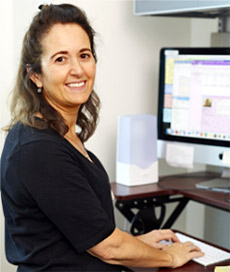Telehealth Visits Improve Outcomes for Students with Asthma
Corey Crawford is enjoying football practice this summer. Corey can run more easily this year because his asthma is under better control, thanks to a telehealth project at his school linking students who have asthma with specialists at Cincinnati Children’s.
Nearly 300 students at Corey’s school have asthma. Some suffer more than others with coughing, wheezing and shortness of breath. The telehealth project was designed to help them.
Consistent, School-based Visits
Cincinnati Children’s offers a clinic for children with severe asthma, but families face barriers to keeping monthly appointments, including lack of transportation, and the burden of parents having to leave work and their children missing school.
Theresa Guilbert, MD, wanted to find another way to serve these patients besides the traditional office visit — and turned to technology.
She introduced a pilot study of telehealth visits at three Cincinnati Public Schools that serve neighborhoods with high rates of asthma. Students enrolled in the study can keep their appointments without leaving their school building.
Computer technology allows Dr. Guilbert to see patients remotely and listen to their lungs using a specially adapted stethoscope. With consistent monitoring, she can see problems and improvements, and adjust medication regimens as needed.
Another piece of technology — a sensor attached to the students’ inhalers and synched with their cell phones — tracks whether they take their medicine as prescribed and sends reminders when they miss doses.
The students also have regular visits with health psychologist Rachelle Ramsey, PhD, who works on improving their self-management skills.
For Corey, wanting to be active in sports was a big motivator for being more consistent taking his medicine. And consistency paid off.
At a recent appointment, Dr. Guilbert gave him good news: “Your lungs sound great.” She’ll monitor how he does with football and will adjust his medicine if necessary so he can keep playing the game he loves.
Top-notch care requires top-notch research.
Investigators at Cincinnati Children’s are studying the genetic, biologic, and environmental causes of asthma, and are seeking new, improved treatments.
Studies include:
- Pilot study of a newly discovered drug for treating asthma
- Leading a statewide study of best practices for treating hospitalized patients
- Part of a national consortium working to improve understanding of difficult to treat asthma and to find new treatment





